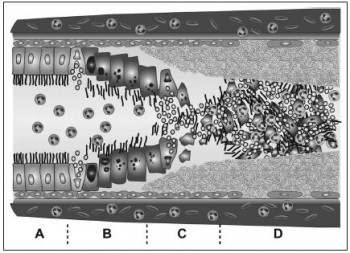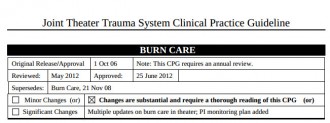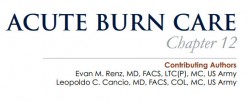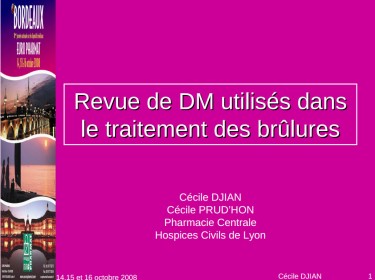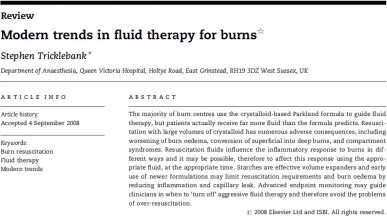01/07/2016
U.K. Military Burns 2008–2013
Epidemiology of U.K. Military Burns 2008–2013
J Burn Care Res. 2016 Jun 2. [Epub ahead of print]
After sustaining burn injuries overseas, U.K. Armed Forces personnel are evacuated to the Royal Centre for Defence Medicine. The objective was to review the etiology of U.K. Military burns managed at the center between 2008 and 2013. Analysis will aid provision planning and assist in the prevention of burn injuries for future tours. The International Burn Injury Database database of all U.K. Armed Forces burn injured patients evacuated to the Queen Elizabeth University Hospital Birmingham between 2008 and 2013 were reviewed retrospectively. Analysis included patient demographics, injury mechanism, burn severity, management, and mortality. There were 65 military personnel with burn injuries requiring repatriation to the United Kingdom. Percentage of 78.5 were sustained in Afghanistan. The mean age was 25 (18–46) years. Percentage of 70.8 were considered noncombat burn injuries. Of the noncombat burns, the mechanism of injury most commonly involved burning waste and misuse of fuels and scalds.
| Combat | |
| Improvised explosive device | 10 |
| Unintentional detonation of ammunition | 3 |
| Rocket propelled grenade | 2 |
| Mini-flare fired into face | 1 |
| Explosion during training | 1 |
| Thermal injury from fired bullet | 1 |
| White phosphorus flame burn | 1 |
| Non combat | |
| Misuse of fuel | 11 |
| Burning waste | 7 |
| Cooking | 4 |
| Others | 16 |
| Total | 65 |
"...One fifth of all patients sustained associated injuries, of which 88.3% were personnel with combat burns. Associated injuries included complex fractures,
tympanic injuries, ophthalmic injury, spinal injury, lung contusions, a gunshot wound to the upper limb and a gunshot wound causing an intracranial hemorrhage. One patient required bilateral lower limb amputations. In addition, two patients sustained an associated inhalation injury..."
The mean TBSA for all patients was 6% (0.05–51%). Areas most commonly affected included arms, legs, and face. The length of hospital stay for combat vs noncombat burn injury patients was 10 vs 7 days. There were no fatalities. In conclusion, substantially fewer military personnel sustained combat burns between 2008 and 2013 than in preceding study period (19 vs 79). The number of accidental noncombat burns remained constant. The decrease in combat burns may reflect a relative decrease in military intensity and effective protective equipment and safety measures. Further education may allow for an additional decrease in preventable burn injuries.
| Tags : brûlure
20/12/2015
Brûlés: Pas plus de suicides que les autres ?
Postdischarge Cause-of-Death Analysis of Combat-Related Burn Patients
Escolas SM et Al. J Burn Care Res 2015;XXX:00–00
----------------------------------------------
Le document proposé rapporte le devenir des blessés brûlés par l'armée américiane lors des conflits afhgans et irakiens. Ces brûlés ont une surface moyenne relativement faible de l'ordre de 12% pour un ISS de 9 et une durée moyenne d'hospitalisation de 15 jours. La mortalité à long terme apparaît elle aussi plutôt faible de l'ordre de 1.3%. La brûlure ne serait donc pas un facteur aggravant notamment de suicide chez ces combattants. L'inclusion des ces combattants dans des programmes très structuré de réhabilitation et un lien social très fort expliquerait ces données.
----------------------------------------------
Combat operations in Iraq and Afghanistan have resulted in up to 8.8% of combat-related casualties suffering burns. From World War I through Desert Storm, burns have been associated with approximately 4% of the combat-related deaths. Experiencing a blast injury and exposure to killing and death while deployed has been shown to increase suicide risk. Although several studies of military populations have investigated risk factors for death among burn patients during the acute phase, no studies have reported mortality rates, cause-of-death, or the prevalence of suicide after hospital discharge. This study examined the case fatality rate, causes of death, and the prevalence of suicide among 830 combat burn patients discharged from the sole burn center in the U.S. Department of Defense, between March 7, 2003 and March 6, 2013. Cause-of-death was determined through the Armed Forces Medical Examiner’s Office and the Office of the Secretary of Defense’s National Death Index. A total of 11 deaths occurred among the 830 burn survivors, for an overall case fatality rate of 1.3%. Of the 11 who died, five deaths were related to accidental poisoning by exposure to drugs; three were related to operations of war (two after returning to the war zone), and the remaining three died from other accidental causes (one explosion and two vehicle crashes). There was no indication of suicide or suspicion of suicide as a cause-of-death for the former patients included in this study, suggesting that combat burn injury did not appear to increase the risk of death by suicide in our study population. Further research is needed to understand the factors that contribute to the apparent resilience of combat burn survivors.
| Tags : brûlure
08/03/2015
Brûlés et transport aérien
Transport aérien longue distance des brûlés graves: Revue de la littérature et application pratique
Leclerc T. et Al. Annals of Burns and Fire Disasters - Pending Publication
Les brûlés graves nécessitent une prise en charge multidisciplinaire dans descentres hautement spécialisés. La rareté de ces centres impose souvent le transport aérien médicalisé longue distance. Cependant, il y a peu de données publiées sur ces transferts. Dans cette mise au point, pour optimiser la prise en charge des brûlés dès qu’un transport aérien est décidé ou même seulement envisagé, nous proposons d’extraire de cette littérature limitée des principes simples s’appuyant aussi sur l’expérience pratique du Service de Santé des Armées françaises. Nous décrivons d’abord comment les contraintes aéronautiques peuvent affecter le transport de brûlés graves à bord d’aéronefs. Nous abordons ensuite la régulation de ces missions, en analysant les risques associés au transport aérien des brûlés graves et leurs implications sur les indications, la chronologie et les modalités du transport. Enfin, nous développons la conduite de la mission, comprenant la préparation du matériel et des consommables avant le vol, l’évaluation et la mise en condition du patient avant l’embarquement, et la poursuite de la prise en charge en vol
| Tags : brûlure
10/02/2014
Inhalation de fumées: Héparine en aérosol ?
Inhaled Anticoagulation Regimens for the Treatment of Smoke Inhalation–Associated Acute Lung Injury: A Systematic Review*
Miller AC et Al. Crit Care Med 2014; 42:413–419
----------------------------------------------------------------------------------------------
L'inhalation de fumées est fréquentes lors de la prise en charge de victilmes par explosion. Laprise en charge de brNébiliser 5000 à 1000U d'héparine inhalé avec 3ml de NacétylCystéine et de l'albuterol améliorerait la survie
----------------------------------------------------------------------------------------------
OBJECTIVE:
Inhaled anticoagulation regimens are increasingly being used to manage smoke inhalation-associated acute lung injury. We systematically reviewed published and unpublished preclinical and clinical trial data to elucidate the effects of these regimens on lung injury severity, airway obstruction, ventilation, oxygenation, pulmonary infections, bleeding complications, and survival.
DATA SOURCES:
PubMed, Scopus, EMBASE, and Web of Science were searched to identify relevant published studies. Relevant unpublished studies were identified by searching the Australian and New Zealand Clinical Trials Registry, World Health Organization International Clinical Trials Registry Platform, Cochrane Library, ClinicalTrials.gov, MINDCULL.com, Current Controlled Trials, and Google.
STUDY SELECTION:
Inclusion criteria were any preclinical or clinical study in which 1) animals or subjects experienced smoke inhalation exposure, 2) they were treated with nebulized or aerosolized anticoagulation regimens, including heparin, heparinoids, antithrombins, or fibrinolytics (e.g., tissue plasminogen activator), 3) a control and/or sham group was described for preclinical studies, and 4) a concurrent or historical control group described for clinical studies. Exclusion criteria were 1) the absence of a group treated with a nebulized or aerosolized anticoagulation regimen, 2) the absence of a control or sham group, and 3) case reports.
DATA EXTRACTION:
Ninety-nine potentially relevant references were identified. Twenty-seven references met inclusion criteria including 19 preclinical references reporting 18 studies and eight clinical references reporting five clinical studies.
DATA SYNTHESIS:
A systematic review of the literature is provided. Both clinical and methodological diversity precluded combining these studies in a meta-analysis.
CONCLUSIONS:
The high mortality associated with smoke inhalation-associated acute lung injury results from airway damage, mucosal dysfunction, neutrophil infiltration, airway coagulopathy with cast formation, ventilation-perfusion mismatching with shunt, and barotrauma. Inhaled anticoagulation regimens in both preclinical and clinical studies improve survival and decrease morbidity without altering systemic markers of clotting and anticoagulation. In some preclinical and clinical studies, inhaled anticoagulants were associated with a favorable effect on survival. This approach appears sufficiently promising to merit a well-designed prospective study to validate its use in patients with severe smoke inhalation-associated acute lung injury requiring mechanical ventilation.
| Tags : brûlure
14/04/2013
Brûlés: Les nouvelles tendances militaires
| Tags : brûlure
Brûlés: L'expérience US
| Tags : brûlure
Brûlure: La procédure US
| Tags : brûlure
Brûlure: OEF/OIF Learned lessons
| Tags : brûlure
Brulure: Une revue des pansements
| Tags : brûlure
Brûlés: Un point sur le remplissage vasculaire
| Tags : brûlure
Brûlés: Réanimation initiale
Réanimation initiale du brûlé
Benyamina Mourad & Losser Marie-Reine
Centre de Traitement des Brûlés, Hôpital Cochin
27 rue du Faubourg Saint-Jacques 75679 PARIS Cedex 14
Service d’Anesthésie-Réanimation, Hôpital Saint-Louis,
1 avenue Claude Vellefaux, 75475 PARIS Cedex 10
| Tags : brûlure

